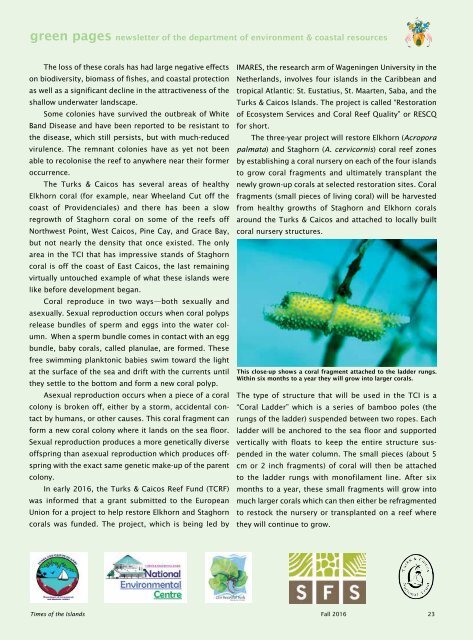Times of the Islands Fall 2016
Presents the "soul of the Turks & Caicos Islands" with in-depth features about local people, culture, history, environment, businesses, resorts, restaurants and activities.
Presents the "soul of the Turks & Caicos Islands" with in-depth features about local people, culture, history, environment, businesses, resorts, restaurants and activities.
Create successful ePaper yourself
Turn your PDF publications into a flip-book with our unique Google optimized e-Paper software.
green pages newsletter <strong>of</strong> <strong>the</strong> department <strong>of</strong> environment & coastal resources<br />
The loss <strong>of</strong> <strong>the</strong>se corals has had large negative effects<br />
on biodiversity, biomass <strong>of</strong> fishes, and coastal protection<br />
as well as a significant decline in <strong>the</strong> attractiveness <strong>of</strong> <strong>the</strong><br />
shallow underwater landscape.<br />
Some colonies have survived <strong>the</strong> outbreak <strong>of</strong> White<br />
Band Disease and have been reported to be resistant to<br />
<strong>the</strong> disease, which still persists, but with much-reduced<br />
virulence. The remnant colonies have as yet not been<br />
able to recolonise <strong>the</strong> reef to anywhere near <strong>the</strong>ir former<br />
occurrence.<br />
The Turks & Caicos has several areas <strong>of</strong> healthy<br />
Elkhorn coral (for example, near Wheeland Cut <strong>of</strong>f <strong>the</strong><br />
coast <strong>of</strong> Providenciales) and <strong>the</strong>re has been a slow<br />
regrowth <strong>of</strong> Staghorn coral on some <strong>of</strong> <strong>the</strong> reefs <strong>of</strong>f<br />
Northwest Point, West Caicos, Pine Cay, and Grace Bay,<br />
but not nearly <strong>the</strong> density that once existed. The only<br />
area in <strong>the</strong> TCI that has impressive stands <strong>of</strong> Staghorn<br />
coral is <strong>of</strong>f <strong>the</strong> coast <strong>of</strong> East Caicos, <strong>the</strong> last remaining<br />
virtually untouched example <strong>of</strong> what <strong>the</strong>se islands were<br />
like before development began.<br />
Coral reproduce in two ways—both sexually and<br />
asexually. Sexual reproduction occurs when coral polyps<br />
release bundles <strong>of</strong> sperm and eggs into <strong>the</strong> water column.<br />
When a sperm bundle comes in contact with an egg<br />
bundle, baby corals, called planulae, are formed. These<br />
free swimming planktonic babies swim toward <strong>the</strong> light<br />
at <strong>the</strong> surface <strong>of</strong> <strong>the</strong> sea and drift with <strong>the</strong> currents until<br />
<strong>the</strong>y settle to <strong>the</strong> bottom and form a new coral polyp.<br />
Asexual reproduction occurs when a piece <strong>of</strong> a coral<br />
colony is broken <strong>of</strong>f, ei<strong>the</strong>r by a storm, accidental contact<br />
by humans, or o<strong>the</strong>r causes. This coral fragment can<br />
form a new coral colony where it lands on <strong>the</strong> sea floor.<br />
Sexual reproduction produces a more genetically diverse<br />
<strong>of</strong>fspring than asexual reproduction which produces <strong>of</strong>fspring<br />
with <strong>the</strong> exact same genetic make-up <strong>of</strong> <strong>the</strong> parent<br />
colony.<br />
In early <strong>2016</strong>, <strong>the</strong> Turks & Caicos Reef Fund (TCRF)<br />
was informed that a grant submitted to <strong>the</strong> European<br />
Union for a project to help restore Elkhorn and Staghorn<br />
corals was funded. The project, which is being led by<br />
IMARES, <strong>the</strong> research arm <strong>of</strong> Wageningen University in <strong>the</strong><br />
Ne<strong>the</strong>rlands, involves four islands in <strong>the</strong> Caribbean and<br />
tropical Atlantic: St. Eustatius, St. Maarten, Saba, and <strong>the</strong><br />
Turks & Caicos <strong>Islands</strong>. The project is called “Restoration<br />
<strong>of</strong> Ecosystem Services and Coral Reef Quality” or RESCQ<br />
for short.<br />
The three-year project will restore Elkhorn (Acropora<br />
palmata) and Staghorn (A. cervicornis) coral reef zones<br />
by establishing a coral nursery on each <strong>of</strong> <strong>the</strong> four islands<br />
to grow coral fragments and ultimately transplant <strong>the</strong><br />
newly grown-up corals at selected restoration sites. Coral<br />
fragments (small pieces <strong>of</strong> living coral) will be harvested<br />
from healthy growths <strong>of</strong> Staghorn and Elkhorn corals<br />
around <strong>the</strong> Turks & Caicos and attached to locally built<br />
coral nursery structures.<br />
This close-up shows a coral fragment attached to <strong>the</strong> ladder rungs.<br />
Within six months to a year <strong>the</strong>y will grow into larger corals.<br />
The type <strong>of</strong> structure that will be used in <strong>the</strong> TCI is a<br />
“Coral Ladder” which is a series <strong>of</strong> bamboo poles (<strong>the</strong><br />
rungs <strong>of</strong> <strong>the</strong> ladder) suspended between two ropes. Each<br />
ladder will be anchored to <strong>the</strong> sea floor and supported<br />
vertically with floats to keep <strong>the</strong> entire structure suspended<br />
in <strong>the</strong> water column. The small pieces (about 5<br />
cm or 2 inch fragments) <strong>of</strong> coral will <strong>the</strong>n be attached<br />
to <strong>the</strong> ladder rungs with mon<strong>of</strong>ilament line. After six<br />
months to a year, <strong>the</strong>se small fragments will grow into<br />
much larger corals which can <strong>the</strong>n ei<strong>the</strong>r be refragmented<br />
to restock <strong>the</strong> nursery or transplanted on a reef where<br />
<strong>the</strong>y will continue to grow.<br />
<strong>Times</strong> <strong>of</strong> <strong>the</strong> <strong>Islands</strong> <strong>Fall</strong> <strong>2016</strong> 23

















